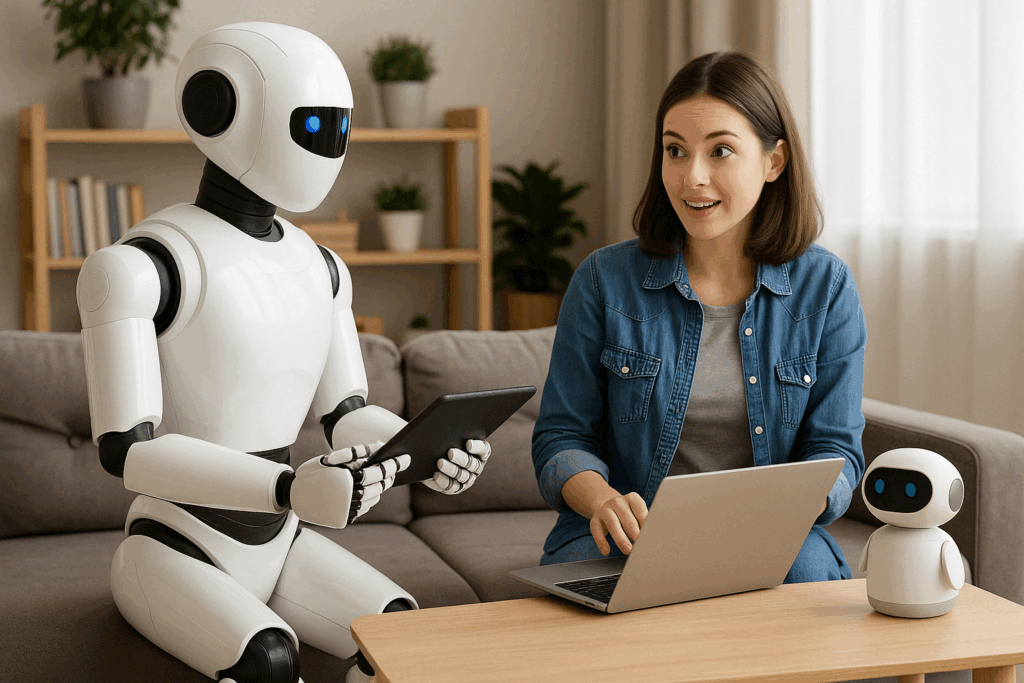
Artificial Intelligence (AI) and robotics are no longer reserved for science fiction. They’ve transitioned from futuristic concepts to everyday realities, deeply embedded in how we live, work, communicate, and play. From voice assistants that schedule our meetings to robotic arms in hospitals, AI and robotics have rapidly evolved—and their impact is only accelerating.
This blog explores the fascinating journey of how these technologies have transformed our lives over the decades and where they’re heading next.
🤖 The Early Days: Mechanical Minds and Dreams
The idea of creating artificial beings dates back thousands of years, but practical development began in the mid-20th century. Early robots were simple, mechanical devices used in industrial automation. At the same time, pioneers like Alan Turing laid the theoretical foundations for machine intelligence with the Turing Test, asking: “Can machines think?”
In the 1950s–70s, robotic arms started appearing in automotive factories, while early AI programs like ELIZA (a primitive chatbot) simulated human conversation for the first time.
📈 The Rise of AI: From Lab to Laptop
The 1980s and 1990s saw a burst of innovation. AI evolved from rule-based systems into machine learning, allowing computers to “learn” from data rather than follow fixed instructions.
At the same time, personal computers became common in households, and robotics quietly entered industries like:
- Agriculture (automated harvesters)
- Medicine (robotic surgery assistants)
- Logistics (warehouse automation)
But AI wasn’t yet visible to the average person—until the internet changed everything.
📱 The Smart Age: AI in Your Pocket
The 2000s and 2010s brought a tech revolution. Smartphones, smart homes, and cloud computing made AI more accessible and practical than ever.
AI-powered tools became part of our daily routines:
- Voice assistants like Siri, Alexa, and Google Assistant
- Recommendation engines on Netflix, Spotify, and YouTube
- Facial recognition in phone security and social media
- Autocorrect and predictive text in messaging apps
- Smart home devices like thermostats, lights, and vacuums
Meanwhile, robots became more personal. Devices like Roomba cleaned our floors, while robotic pets and toys entertained kids and assisted in therapy sessions.
🚗 Mobility and Automation: Driving the Future
AI has revolutionized transportation. Self-driving car development led by Tesla, Waymo, and others is no longer experimental—it’s happening now. Autonomous features like lane assist, parking, and emergency braking are already embedded in today’s vehicles.
Delivery drones, robot dogs from Boston Dynamics, and warehouse bots from Amazon have made logistics faster, safer, and cheaper.
🏥 AI in Healthcare: Saving Lives
Robotics and AI are transforming medicine and caregiving:
- AI algorithms detect cancer, heart disease, and more with high accuracy.
- Robotic surgical systems like the da Vinci assist doctors in complex procedures.
- Wearable devices monitor heart rate, sleep, and activity levels in real time.
- Elder care robots help with reminders, mobility, and companionship.
AI isn’t just improving care—it’s extending lives.
🧠 Generative AI and Virtual Companions
In recent years, generative AI—like ChatGPT—has ushered in a new era. People now use AI to:
- Write essays, blogs, and emails
- Create art, music, and designs
- Build business plans and code websites
- Talk to AI companions for mental health, coaching, or casual chats
These tools are not only practical—they’re creative, emotional, and deeply human in their interaction.
🏠 Robots at Home: From Helpers to Friends
Modern robotics has moved beyond simple automation. Today’s robots are smarter, more adaptive, and often charming:
- Robot vacuum cleaners map homes and empty themselves
- AI-enabled fridges suggest recipes based on ingredients
- Companion robots like ElliQ or Moxie engage with the elderly and children
- Pet-like robots offer emotional support without allergies or feeding
Homes are becoming intelligent ecosystems, seamlessly responding to our needs.
🌍 Looking Ahead: Ethical and Social Impact
With power comes responsibility. As AI and robots grow more integrated into society, questions arise:
- Privacy: Who owns your data?
- Jobs: Will automation replace human workers?
- Bias: Can AI discriminate if trained on flawed data?
- Autonomy: How much decision-making should machines have?
The challenge moving forward is to ensure ethical AI—technology that empowers and respects human rights.
✨ Final Thoughts
The evolution of AI and robotics is one of the most profound changes in human history. What began as clunky machines and coded logic has transformed into smart assistants, creative partners, and even emotional companions. We’re not just using technology—we’re collaborating with it.
And while we can’t predict everything, one thing’s clear: AI and robotics are no longer the future—they’re the present.
#artificialintelligence #roboticsrevolution #futuretech #smarthome #aieveryday #robotatwork #healthcareai #selfdrivingcars #chatgpt #generativeai #robothelpers #aiethics #automationlife #intelligentsystems #aiinhealthcare #techinnovation #machinelearninglife #aiinbusiness #aiandrobots #robotcompanions #roboticsinmedicine #dailyai #smarthouselife #roboevolution #digitalassistants #voicecontrolledtech #aiandyou #robotfuture #techlifestyle #aiinreallife